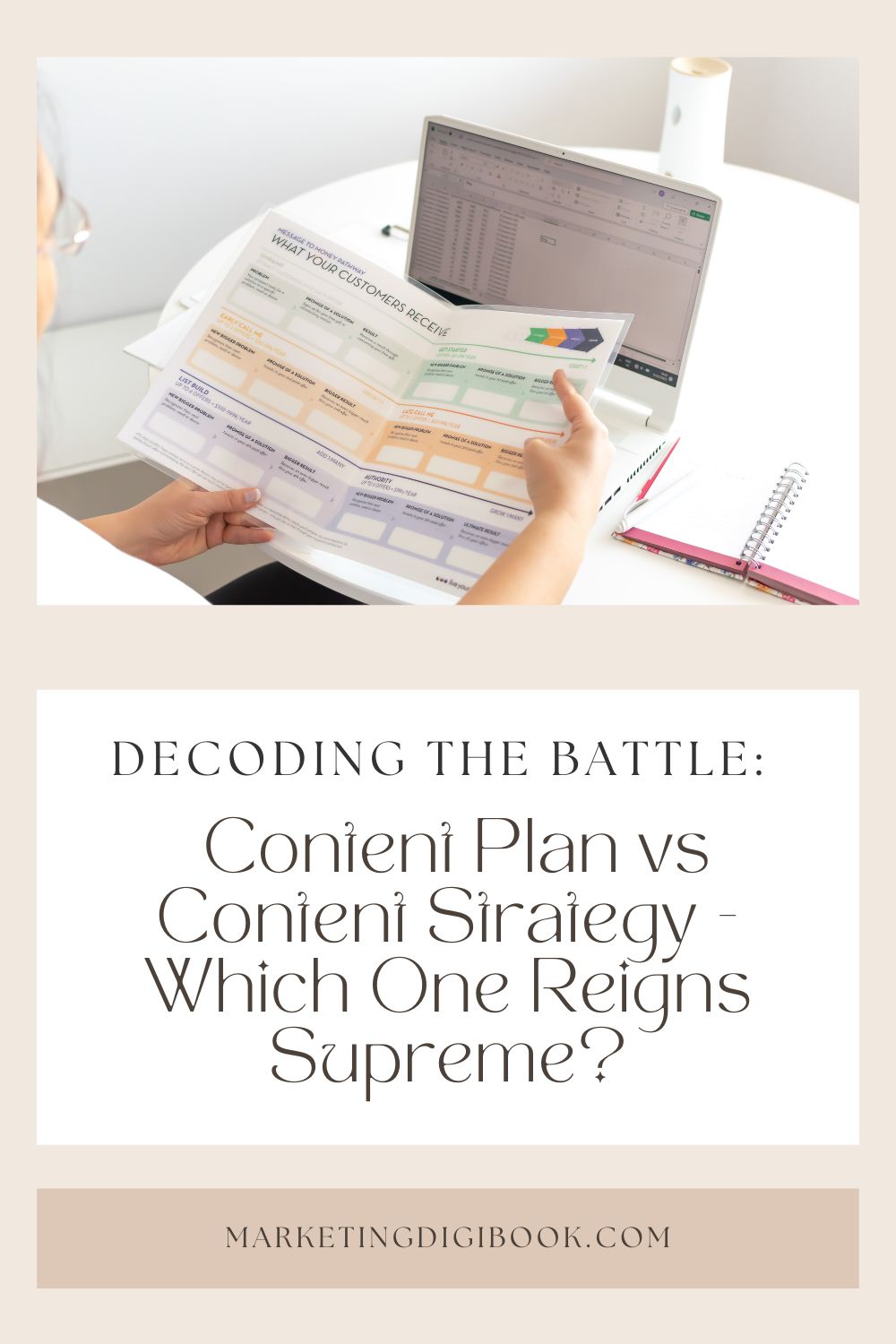A direct comparison of content strategy vs. content plan is necessary to clearly understand what is the scope of each of them and how to obtain maximum benefits from using them correctly.
What Is a Content Strategy?
Content strategy refers to the strategic approach and framework employed by businesses in developing and managing their content assets. It involves the careful planning, creation, distribution, and analysis of content to meet specific business goals.
Each content strategy takes into account factors such as target audience, brand positioning, and market research to ensure that the content resonates with the buyer persona and achieves desired outcomes.
Let’s Make Your SEO & Content Work Better for Your Business
What Is a Content Plan?
A content plan is a tactical roadmap that outlines the specific actions and steps required to execute a content strategy effectively. It provides a detailed schedule and action plan for content creation, distribution, and promotion. The content plan is the core part of a content strategy.
Typically it includes elements such as a content calendar, content types and formats, distribution channels, and strategies for amplifying content reach. It serves as a blueprint for businesses to implement their content strategy in a structured and organized manner.
Importance of Content Strategy vs Content Plan in Digital Marketing
- Content strategy:
- Provides clear direction, goals, and guidelines
- Identifies target audience and tailors content accordingly
- Increases brand awareness, engagement, and conversions
- Content plan:
- Translates strategy into actionable steps
- Streamlines content creation and maintains consistency
- Maximizes impact through optimized distribution
Understanding the Content Strategy
Definition and purpose of content strategy
- Content strategy: Strategic approach to content development and management
- Purpose: Guide businesses in creating and distributing content to achieve specific objectives
Key components of a content strategy
- Target audience identification
- Identifying the buyer persona for the content
- Understanding their demographics, interests, and needs
- Goal setting
- Defining specific goals and objectives for the content strategy
- Examples: increasing brand awareness, driving website traffic, boosting conversions
- Brand positioning
- Establishing a unique brand identity and value proposition
- Aligning content with brand messaging and values
- Content research and analysis
- Conducting research to understand market trends and audience preferences
- Analyzing competitor content strategies and identifying content gaps
- Content creation and management
- Developing high-quality, relevant, and engaging content
- Managing content production, organization, and distribution processes
Benefits of a well-defined content strategy
- Enhanced brand visibility and awareness
- Stronger brand positioning and differentiation
- Effective targeting and personalization of content
- Increased audience engagement and interaction
- Improved conversions and customer loyalty
- Consistency and coherence across all content channels
- Better utilization of resources and improved ROI
Exploring Content Plans
Definition and purpose of content plans
- Content plans: Tactical roadmaps for executing content strategies
- Purpose: Provide a detailed framework for content creation, distribution, and promotion
Elements of a content plan
- Content calendar
- Organizes content creation and publication schedule
- Ensures consistent and timely delivery of content
- Content types and formats
- Determines the specific formats and types of content to be used
- Examples: blog posts, videos, infographics, podcasts
- Distribution channels
- Identifies the platforms and channels for content distribution
- Examples: website, social media networks, email marketing
- Content promotion and amplification strategies
- Outlines tactics to increase content reach and engagement
- Examples: social media advertising, influencer collaborations, SEO optimization
The role of content plans in executing a content strategy
- Content plans translate the strategic goals into actionable steps
- Provide a structured approach to implementing content strategies effectively
Benefits of a comprehensive content plan
- Improved organization and efficiency in content creation and distribution
- Ensures consistent messaging and brand coherence across channels
- Enables strategic content promotion and amplification for maximum impact
- Facilitates monitoring and optimization of content performance
- Enhances audience targeting and personalization of content
- Maximizes the return on investment (ROI) for content marketing efforts

Visuals are the first vector of sales.
Use Professional Styled Stock Photography to Promote Your Business.
Content Strategy vs. Content Plan – Key Differences
Key distinctions between content strategy and content plan
Scope and focus
- Content strategy: Broad, overarching approach to content development and management
- Content plan: Specific, detailed roadmap for executing the content strategy
Timeframe and flexibility
- Content strategy: Long-term vision and goals for content initiatives
- Content plan: Shorter-term, actionable steps with room for adjustments and adaptability
Strategic vs. tactical approach
- Content strategy: Strategic decisions guiding the “what” and “why” of content
- Content plan: Tactical decisions addressing the “how,” “when,” and “where” of content execution
Cross-channel integration
- Content strategy: Considers overall brand messaging and integration across various channels
- Content plan: Focuses on channel-specific details and content distribution tactics
Complementary nature of content strategy and content plan
- The content strategy and content plan work hand in hand to achieve overall content objectives.
- Content strategy sets the foundation and strategic direction, while the content plan translates strategy into actionable steps.
- The content strategy is the foundation on which the content plan is built, guiding decisions on the target audience, content themes, and messaging.
- Effective execution of the content strategy is the main task of the content plan, providing structure and organization.
- Content strategy and content plan are interdependent and mutually reinforcing, with the strategy driving the plan and the plan implementing the strategy.
The Content Strategy Process
Overview of the content strategy process
- Research and analysis
- Conduct market research, competitor analysis, and audience insights
- Identify content gaps, trends, and opportunities
- Goal setting and objective definition
- Define specific (SMART) goals aligned with overall business objectives
- Examples: increasing brand awareness, driving organic traffic, generating leads, increasing sales
- Audience identification and segmentation
- Identify target audience demographics, behaviors, and preferences
- Segment the audience based on relevant criteria
- Content ideation and creation
- Generate creative ideas for content that resonate with the target audience
- Develop high-quality, engaging, and valuable content pieces
- Content distribution and promotion
- Determine the appropriate channels and platforms for content distribution
- Plan and execute content promotion strategies to maximize reach and engagement
- Measurement and analysis
- Track key metrics and performance indicators to assess the effectiveness of the content strategy
- Analyze data to gain insights, identify areas for improvement, and make data-driven decisions
Case Study/Example of a Successful Content Strategy Implementation:
Company X, a fashion retailer, executed a content strategy with clear actions and measurable outcomes:
- Research and analysis:
- Action: Conducted market research and analyzed three direct competitors.
- Result: Identified content gaps and emerging trends in the fashion industry.
- Goal setting and objective definition:
- Goals: Increase brand visibility by 30%, increase organic traffic by 20%, and boost conversion rates by 15% in the next year.
- Action: Defined these objectives aligned with overall business goals.
- Audience identification and segmentation:
- Segments: Fashion enthusiasts and trend-conscious individuals.
- Action: Identified and segmented the target audience based on demographics and behaviors.
- Content ideation and creation:
- Action: Developed a mix of content types, including 50 blog articles, 20 style guides, and 100 social media visuals.
- Result: Created engaging and relevant content tailored to the target audience’s preferences.
- Content distribution and promotion:
- Action: Leveraged social media platforms (Instagram, Pinterest, TikTok), collaborated with influencers, and implemented targeted email marketing campaigns.
- Result: Reached the target audience effectively through multiple channels.
- Measurement and analysis:
- Metrics tracked: Website traffic, social media engagement, and sales data.
- Action: Monitored the impact of the content strategy and made adjustments based on insights gathered.
- Result: Achieved significant growth in brand visibility, increased organic traffic by 35%, and improved sales conversions by 15%.
The comprehensive content strategy process played a pivotal role in guiding the planning, execution, and measurement of Company X’s content initiatives. Through their strategic approach, they achieved measurable success, including substantial brand visibility growth, increased organic traffic, and improved sales conversions.
The Content Plan Development Process
A step-by-step guide to creating a content plan:
- Aligning with content strategy objectives
- Ensure that the content plan is in line with the goals and objectives defined in the content strategy.
- Reflect the strategic direction and messaging of the overall content strategy.
- Defining content themes and topics
- Identify key themes and topics that align with the target audience’s interests and needs.
- Research industry trends and audience preferences to inform content selection.
- Mapping content to target audience personas
- Understand the different segments within the target audience.
- Create content tailored to each persona, addressing their specific pain points and motivations.
- Creating a content calendar
- Develop a schedule outlining when content will be created, published, and promoted.
- Consider factors such as seasonality, events, and campaign launches.
- Selecting appropriate content formats
- Determine the most effective formats for delivering the content.
- Consider the preferences and behaviors of the target audience.
- Choosing relevant distribution channels
- Identify the channels where the target audience is most active.
- Select platforms that align with the content strategy and optimize content reach.
- Planning content promotion and amplification strategies
- Define strategies for promoting and amplifying the content through various channels.
- Explore partnerships, influencer collaborations, and paid advertising opportunities.
Case Study – Example of a Well-Executed Content Plan:
Company Y, an e-commerce platform, successfully implemented a content plan that resulted in significant improvements in engagement and conversions. Here are the clear actions and numbers involved:
- Aligned with content strategy objectives:
- Objective: Increase user engagement by 25% and drive sales with a 20% conversion rate boost.
- Action: Aligned the content plan with these objectives.
- Defined content themes and topics:
- Identified themes: Product reviews, buying guides, and user-generated content.
- Action: Selected these themes to provide value and encourage interaction.
- Mapped content to target audience personas:
- Segments: Beginners and experienced users.
- Action: Developed tailored content addressing their unique needs.
- Created a content calendar:
- Action: Established a consistent publishing schedule with three blog posts, two videos, and ten social media posts per week.
- Result: Maintained audience engagement and met marketing objectives.
- Selected appropriate content formats:
- Formats used: Blog posts, videos, and social media visuals.
- Action: Utilized this mix to cater to diverse audience preferences.
- Chose relevant distribution channels:
- Platforms targeted: Social media platforms (Facebook, Instagram, Pinterest) and relevant online communities.
- Action: Focused on these platforms to reach the active target audience.
- Planned content promotion and amplification strategies:
- Strategies implemented: Targeted social media advertising with a budget of $18,000 per month, influencer collaborations, and encouraged user-generated content.
- Action: Executed these strategies to amplify reach and engagement.
Through this well-executed content plan, Company Y achieved good results:
- Increased engagement by 30% with higher interaction rates on social media platforms.
- Boosted sales with a conversion rate increase of 15%.
- Maintained a consistent publishing schedule resulting in improved brand visibility.
- Utilized diverse content formats to cater to audience preferences effectively.
- Targeted active distribution channels for maximum reach.
- Amplified reach and engagement through strategic promotion tactics.
Integration and Optimization
Importance of integrating content strategy vs. content plan
- Aligns efforts towards a unified vision and objectives.
- Ensures consistency in messaging and brand positioning.
- Maximizes the effectiveness of content initiatives.
Continuous optimization of content strategy and content plan
- Monitoring and analyzing content performance
- Regularly track key metrics such as engagement, conversions, and audience feedback.
- Evaluate the success of content initiatives based on predefined goals.
- Making data-driven adjustments
- Identify areas for improvement based on performance data and analytics.
- Optimize content elements, such as headlines, visuals, and calls-to-action, to enhance effectiveness.
- Staying up-to-date with industry trends and changes
- Keep abreast of evolving industry trends, consumer behavior, and platform algorithms.
- Adapt content strategy and content plan accordingly to remain relevant and competitive.
The role of content strategy and content plan in achieving business goals
- Content strategy sets the overarching direction and goals, providing a roadmap for success.
- Content plan outlines the specific actions and tactics required to execute the strategy effectively.
- Together, they enable businesses to attract and engage their target audience, build brand authority, drive conversions, and ultimately achieve their desired business outcomes.
The integration of content strategy and content plan ensures synergy and coherence in content efforts, while continuous optimization allows for data-driven improvements and staying ahead of industry trends. Ultimately, the combined role of content strategy and content plan is crucial in aligning content initiatives with business goals, driving growth, and fostering long-term success.





